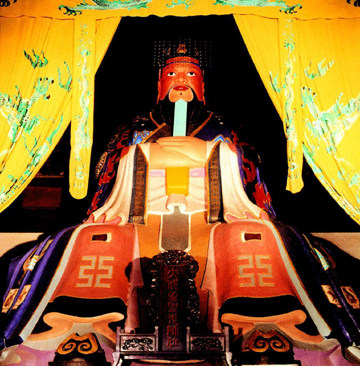南孔家庙和它的奉祀官

一
在浙江衢州这座国家级历史文化名城东南隅,有一片红墙黑瓦、飞檐翘角的古建筑群,这就是被世人誉为“东南阙里”和“南宗尼山”的孔氏南宗家庙。
衢州孔氏南宗家庙是孔子大宗繁衍生息了780多年的地方,也是国务院公布的国家级文物保护单位。
走进孔氏南宗家庙大门,便是大成门前卵石铺地的一个大院子。院子里三棵两人合抱粗的银杏树高入云霄,这三棵明朝初年栽种的银杏与后院的青翠古柏一样,经历了600余年的风雨,风吹树叶的飒飒声,好似在向人们低语:“逝者如斯夫,不舍昼夜!”也似乎在述说蕴藏在它密密年轮中的伟大和悲壮。
院子东墙爬满青苔的古碑中,有一块清康熙年间驻节衢州的兵部尚书李子芳撰写的碑文《重修衢州孔氏家庙碑》。李子芳在碑文中写道:“自唐开元后郡邑皆立孔子庙,有司岁时奉祠,至于今不废;而为孔子家庙者,遍行天下唯曲阜与衢州耳。”也就是说孔子家庙全国仅山东曲阜和浙江衢州两座。
衢州之所以建孔氏家庙,是由于北宋末期金兵占领开封,1128年宋高宗赵构南渡在临安(杭州)建都,孔子四十八代嫡长孙、衍圣公孔端友护跸随行,赵构将衢州的州学校舍赐予孔端友暂作“家庙”,孔氏大宗就此安家繁衍生息。
岁月悠悠,历史变迁,朝代更迭,在元始祖忽必律统一中国之后,至元十九年(1282年)八月,元始祖召衢州第六代衍圣公(孔子五十三世宗子)孔洙赴京,令他载爵去曲阜奉祀。孔洙以先祖庐墓在衢州,且衢州已建家庙,不忍举家北上为由,让爵给曲阜族弟孔治。元始祖称赞孔洙“于违荣而不违道,真圣人后也”。由此,孔氏这“天下第一家族”遂分成南、北两宗,衢州的孔氏家庙也随之称为“孔氏南宗家庙”。
失去爵位后的孔氏南宗自此走向民间,或为学官,或当山长,建校办学,训育少年,弘道乡里,教化平民,活跃于东南诸省,为儒学南渐、理学北传贡献自己的聪明才智,直至明朝正统元年(1436年),英宗皇帝下旨“访求衍圣公孔端友后”,孔洙六世孙(也就是孔子五十九世宗子)孔彦绳遂于正德元年(1506年)重新被封为“世袭翰林院五经博士”,以奉家庙祭祀。1919年、1935年,国民政府先后改任孔子南、北两地宗子为“大成至圣先师南宗奉祀官”与“大成至圣先师奉祀官”。最后一位“大成至圣先师南宗奉祀官”孔祥楷,是孔子七十五代嫡长孙,于1944年10月袭任,虚龄7岁,今年已69岁。
二
孔氏南宗家庙占地13900平方米,分家庙、孔府、孔园三部分。
衢州孔氏南宗家庙先为衢州州学校舍代替,后于宋理宗宝元年(1253年)由朝廷拨款36万缗(一千铜钱为一缗),按曲阜家庙规模建造,达二百余楹,不过尔后又毁于兵燹,不存片瓦。现存家庙建于明朝正德年间,规模仍仿宋制,此后屡毁屡修。1948年国民政府曾拨款小修,1984年始,在近五年间,衢州市政府投入50余万元对大成殿、思鲁阁、大成门和两庑进行了修葺,而且重建了圣泽楼,到了1998年,衢州市人民政府又投资近2000万元复建了家庙西轴线上的五支祠、袭封祠、六代公爵祠以及孔府、花园等,这一工程于2000年5月竣工,建筑面积2086平方米。

修葺一新的孔氏南宗家庙,由庙门、大成门、佾台、大成殿、东西两庑、五支祠、袭封祠、六代公爵祠和思鲁阁、圣泽楼组成。在气势恢宏的大成殿前和大成殿中,分别高悬着康熙皇帝题写的匾额“万世师表”和雍正皇帝书写的匾额“生民未有”。大成殿中帝王装束的孔子彩塑像高达4.5米,两侧的伯鱼、子思塑像亦栩栩如生,殿内柱子上挂着雍正和干龙写的两副楹联,分别是“德冠生民溯地辟天开咸尊首出,道降群圣统金声玉振共仰大成”、“气备四时与天地鬼神日月合其德,教垂万世继尧舜禹汤文武作之师”。
东庑陈列着六位有代表性的孔氏大宗先祖的塑像,依次是孔仁玉、孔端友、孔传、孔洙、孔彦绳、孔庆仪;西庑陈列着宋、金战争局势图和孔氏南宗史迹,以及有关孔氏南宗让爵与复爵的青石浮雕。
思鲁阁内供着两件“镇庙之宝”:孔子夫妇楷木像和先圣遗像碑。楷木像为端木子贡所刻,先圣遗像系唐代画家吴道子所绘,由孔端友随跸南渡带到衢州描摹勒石。孔子夫妇楷木像高60厘米,褐色。孔子长袍大袖,亓官夫人长裙曳地,形象生动。先圣遗像碑高2.07米,宽0.85米,碑额篆刻“德配大地,道冠古今,删述六经,垂宪万世”十六个大字。刻像向有“衣冠佩剑,有温而厉,威而不猛,恭而安之”的美誉;明正德年间重建家庙时,主事者在碑背补刻新建家庙规模图。此碑乃孔端友与孔传所立,碑右下侧刻有“扈跸南渡四十七世孙兵部尚书传四十八世袭封衍圣公端友敬立”落款,系宋碑,是衢州孔氏南宗家庙中时限最早的古碑。
与家庙一墙之隔的孔府,由于历代孔氏宗子任职名称不同,先后称为“衍圣公府”、“博士府”和“奉祀官府”,由大门、二门、大堂、花厅、碑廊和内宅组成。孔府大门题匾为郑板桥题写的“孔氏先宗”;孔府二门旁悬挂着清代名儒纪晓岚书写的楹联:“与国咸休安富尊荣公府第,同天并老道德文章圣人家。”孔府大堂的匾额为“泗浙同源”,意为曲阜孔氏北宗与衢州孔氏南宗同源。大堂是孔府主人会见各级官员和众议家族重大事宜的客厅,大堂西侧有小花园和碑廊。碑廊由70方镶嵌在粉墙上的青石碑组成,雕刻的是全套《孔子圣迹图》。碑廊前的花木丛中有一巨石,镌有孔祥楷先生的草书“过庭”二字。
与大堂相隔一个天井的花厅,则是普通的会客厅,其后是内宅。内宅是幽静的四合院式建筑,系嫡长孙家眷的居住处,正面的二层楼上珍藏着书籍字画和祖宗画像。
孔园是一个建有亭台阁榭、池塘草坪、假山花树的休憩园林。小渔船横卧水面,古水车倚傍堤岸,红鲤鱼激起水花,清泉水潺潺流淌;鸽群在天空中盘旋,青蛙在荷叶间跳跃;绿孔雀和白水鸭旁若无人地在草坪上漫步:“百鸟房”里啾啁的小鸟和亭台间流出的悠悠古乐,以及从“大中堂”飘出的袅袅茶香,给恬静的园子增添了浓郁的诗情画意。

三
虚龄七岁袭任“大成至圣先师南宗奉祀官”的孔子七十五代嫡长孙孔祥楷先生,生于1938年。关于孔祥楷的最早记载,见之于1947年9月6日《东南日报》记者雷铖先生的文章《南宗祀孔记》,文中写道:“……南宗现在的奉祀官孔祥楷是一个十岁的小孩子,还在尼山小学念书。奉祀官除享受简任官的待遇之外,国府还要培植其受大学教育。”
1961年,孔祥楷毕业于西安建筑科技大学,曾任河北金厂峪金矿技术员、基建科长、副矿长、矿长。1993年祥楷先生从沈阳黄金学院副院长任上调回故乡衢州,先后任市长助理、市委统战部长、政协副主席等职。由于不习惯南方的气候,加之身体不大好,老伴董悦英女士没有一道南来,故祥楷先生竟成了“单身汉”。夫人虽然不放心丈夫一人独自生活,但她理解丈夫回衢州是为了“圆梦”,“圆”作为孔夫子嫡长孙弘扬儒家文化并为家乡做点只有他才能做到、也只有他那曾经有过的身份才能做好某些事情的“梦”。
孔氏南宗一向重教,祥楷先生主持“孔管会”工作后,不仅对有百年历史的尼山小学多方支持,为他的母校衢州二中编写的“校本教材”《南孔文化》写“序”,而且在孔府办起了免费的“少儿读经班”,并与衢州电台合办“空中《论语》课堂”,做着他老祖宗一代一代做下来的称之为“衍圣弘道”的“梦”。
祥楷先生的“梦”并不虚无缥缈,他除了搞好孔氏南宗家庙的软件、硬件设施建设之外,还着眼于做“衍圣弘道”的基础工作,他物色了几位称之为“翰林院大学士”老先生,以他们为核心建立了孔子学术研究会,又与浙江师范大学、衢州学院(筹)共建“孔氏南宗研究中心”和“孔子文化研究所”,挖掘孔氏南宗史料,研究儒家文化和孔氏南宗对衢州乃至对长江以南社会、经济发展的影响。洋洋二十余万言的《孔氏南宗史料》已经出版,《孔氏南宗史》亦将付梓,《孔氏南宗谱》的编纂亦正在“扫尾”。祥楷先生协助中共衢州市纪律检查委员会编辑出版了《儒家思想与从政道德》一书,并为之写“序”。他在“序”中写道:“儒家有‘修、齐、治、平’之说,‘修’就是要修养自己,不放纵自己,就是要做君子而不做谋图公利为己所有的小人。‘君子喻于义,小人喻于利’,当人远离‘利’之后,自然也就可以近‘义’而为君子了。故而,修身才是治贪的重要途径。这就是德治。”
祥楷先生最大的“梦”莫过于恢复中断了半个多世纪的孔氏南宗祭祀大典。在得到了衢州市委和市政府的同意之后,从2001年开始,经过近三年的征求意见、研讨论证和充分准备,2004年9月28日,即孔子诞辰2555周年纪念日这一天,衢州市成功地举办了首届“中国衢州国际孔子文化节暨祭祀大典”。此次“祭孔”是由衢州市各级政府官员和社会各界代表参加的“公祭”活动,影响很大,特别是祥楷先生提出并实践的“当代人祭孔”的定位,得到国内外儒学研究专家的肯定和赞赏。

祥楷先生在大学里是学工的,但他对文艺有兴趣且有造诣。祥楷先生的多才多艺不仅仅表现在他“心血来潮”时自由自在地写散文、写小说、画国画、写歌曲,更表现在他创作特定主题作品的才华。2003年诗人崔铭先写出了八首反映孔氏南宗历史的歌词,祥楷先生要我和铭先兄推荐谱曲的音乐家,我俩共同推荐了几位,但试写后都不理想。祥楷先生无奈说:“还是我自己写吧!”我等心存疑惑,想不到他一气呵成,一鸣惊人!祥楷先生2002年暑期在沈阳休假时,根据他自己掌握的大量史料和徐寿昌兄提供的一些史料,创作了话剧《大宗南渡》也同样出人意料,如此具有丰富历史文化内涵、如此具有孔氏南宗特色的文学作品,也许只有祥楷先生写得出来。
Southern Temple of Confucius and Its Lord Sacrificer
By Zhuang Yuejiang
The Confucius Temple in Qufu, Shandong Province is well known all over the world. However, this is not the only one in China. Another official Confucius Temple is located in Quzhou in southern Zhejiang Province.
The Confucius family’s southward migration was caused by the war in 1128 in the Southern Song Dynasty (1127-1279). As the troops of the Jin dynasty (1115-1234) stormed south into the central kingdom, the royal family of the Northern Song Dynasty (960-1279) vacated the capital Kaifeng in Henan Province and retreated to Lin’an (today’s Hangzhou in Zhejiang Province) where the Southern Song Dynasty was established in 1128. Kong Duanyou, a 48th-generation descendent of Confucius and Duke Yansheng, followed the emperor to the south. The emperor later granted a prefecture school house in Quzhou as a temporary place for the Confucius family to worship their ancestor. The family settled down in Quzhou. History does not relate explicitly why the temple was in Quzhou, several hundred kilometers south of the dynasty’s capital, but a Confucius temple, a copy of the prototype in Qufu, Shandong Province, was built in Quzhou.
After the Yuan Dynasty (1271-1368) was founded in China, Kublai Khan, the first emperor of the dynasty, summoned Kong Zhu, a 53rd-generation descendent of Confucius and sixth-generation Duke Yansheng, from Quzhou to the capital Dadu (today’s Beijing) in 1282. Kong was asked to move back to Qufu and continue to act as the Lord Sacrificer to Confucius for the family temple in the north. Kong declined the offer on the excuse that his ancestors’ tombs were in Quzhou where there was a Confucius family temple, therefore he was unwilling to uproot the whole family and move back to the north. Kong then offered to resign the official title and dukedom to his cousin Kong Zhi in Qufu. Touched by his resignation, the emperor approved his proposal. This is how the family in the south lost their official title and dukedom in 1282. Since then, the Confucius family has had two temples.
Without government subsidies, the descendents of Confucius in the south made a living mostly by working as teachers and occasionally as petty officials. Their influences as educators promoting China’s first teacher’s ideas were mostly in southeast provinces. In 1456, Emperor Yingzhong of the Ming Dynasty (1368-1644) issued a decree to search and honor the descendent of Kong Duan who had resigned the dukedom in the Yuan Dynasty. As a result, Kong Yanshen, a 6th-generatoin descendent of Kong Duan and 59th generation descendent of Confucius, was granted a hereditary title to officiate sacrificial ceremonies at the Confucius Temple in the south. By receiving this title, the family in the south regained government subsidies. In 1935, the National Government bestowed the title of the Sacrificial Officer of the Great Accomplished and Most Sacred Teacher to the Confucius family in the south. In 1944, the title was passed on to Kong Xiangkai who was 6 years old that year. He is 69 in 2007.
Kong Xiangkai was born in 1938 as a 75th-generation descendent of Confucius. The earliest media coverage about him was a piece of news about a sacrificial ceremony held at the Confucius Temple in Quzhou in the local newspaper Southeast Daily on September 6, 1947.
In 1961, Kong Xiangkai graduated from Xi’an Architectural Sciences University. He worked for a gold mine as a technician and then as a manager in Hebei Province for years. In 1993 when he was vice president of Shenyang Technical College of Gold, he was transferred back to Quzhou and began working for the city government as a high-ranking official there.
Though Kong worked in the Quzhou Government, his comeback was totally due to his 1944 appointment, which had been neither dismissed nor recognized officially since 1949, and his main work has been to administer the Confucius Temple and related affairs in Quzhou.
The temple needed to be administered. It was first built in 1253 in the exact pattern of the prototype in Qufu. In subsequent centuries the temple came to total ruins due to wars. The present temple was rebuilt in the Ming Dynasty. In 1948, the National Government allotted some fund for a small-scale repair project in the temple. In 1984, the Quzhou Government assigned 500,000 yuan for a five-year repair project. In 1998, the government allocated another 20 million for restoring the temple to its Song Dynasty grandeur. The project was finished in 2000.
The Confucius family in the south has always attached importance to education. Since his comeback, Kong Xiangkai has managed to sponsor a radio program on The Analects of Confucius and offer free-of-charge reading courses at the Confucius Family Residence beside the temple for local youngsters to study ancient Chinese classics. Kong Xiangkai has established a Confucius Research Association and engaged some veteran scholars to work there. In collaboration with Zhejiang Teachers University and the College of Quzhou, he set up the Research Center for Southern Confucius Family and the Confucius Culture Research Institute. A series of research results have been published.
Kong Xiangkai’s dearest aspiration was to restart the sacrificial ceremony at the Southern Confucius Temple. His proposal was approved by the local government and preparations started in 2001. On September 28, 2004, the day of Confucius’ 2555 anniversary of birth, a grand sacrificial ceremony was held at the temple in Quzhou, attended by local government officials and people. The way the ceremony was conducted and the rationale for the restart of the sacrificial ceremony were highly praised by Confucius experts at home and abroad.
(Translated by David)
版权声明:
1.文驰范文网的资料来自互联网以及用户的投稿,用于非商业性学习目的免费阅览。
2.《南孔家庙和它的奉祀官》一文的著作权归原作者所有,仅供学习参考,转载或引用时请保留版权信息。
3.如果本网所转载内容不慎侵犯了您的权益,请联系我们,我们将会及时删除。
本栏目阅读排行
栏目最新
- 1银行党支部抓党建工作责任清单
- 22024平安建设经验做法:打好基层治理“组合拳”,夯实平安建设“压舱石”
- 32024年对新时代老干部工作队伍建设思考【完整版】
- 4党纪条规集中学习月活动知识测试主持词(全文)
- 5X县贯彻落实中央环境保护督察组督察反馈意见整改方案(2024年)
- 6董事长在红色教育主题活动期间讲话(集团公司)(全文完整)
- 72024年县长在全县总河湖长会议上主持讲话
- 82024年研讨发言:锻造忠诚品质品格,坚决对党绝对忠诚
- 92024年度在中学“全国中小学生安全教育日”主题升旗仪式上发言(2024年)
- 10在党风廉政建设工作推进会上讲话【完整版】
- 112024主题教育学习党章心得体会之用党章党规党纪约束自己一言一行(范文推荐)
- 122024年中青班交流研讨会上发言提纲
